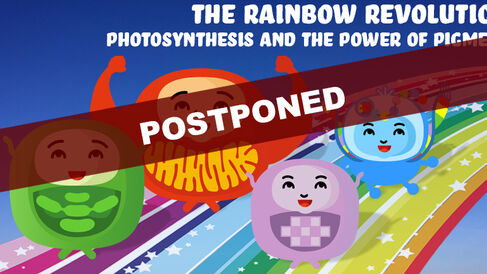
POSTPONED: The Rainbow Revolution:
Photosynthesis and the Power of Pigments.
We have been advised that hands-on activities at the Cambridge Science Festival should be cancelled in line with the current coronavirus (COVID-19) outbreak. As such, we are sadly postponing our Saturday 14th March event, and will run this instead later in the year. We apologise to anyone who was planning on attending. We'll get back to you in due course with plans for the summer instead!
"Let there be light", or should that be "Let there be colour"? Early in the life of the Earth, our brown planet became a pigmented one. Life realised that light could be split into rainbows, its energy trapped and life on the planet powered. This was the photosynthetic revolution. The inventors were the simplest of cells, and the first steps were small. But life is cooperative and it loves to share. The power of colour was borrowed and exchanged. Cells merged with cells. Genes and recipes were swapped. Plants, trees, algae and seaweeds are the products of these complex partnerships with the first pigment-powered cells. And the sharing continues, from corals partnering with algae, to the formation of some of our deadliest foes.
Our Department studies many aspects of the rainbow revolution. At our Science Day, you'll join in the research and become a scientist with us! Together we'll explore the synthesis of the photosynthetic machine and investigate how we can exploit it for green electricity. We'll also discover how different organisms merge and trade technologies, and probe the dark side of sharing that resulted in malaria and similar diseases.
This free, interactive event includes hands-on experiments, informative demonstrations, and plenty of fun activities for children and adults of all ages!
Hands-on experiments and demonstrations
Introduction to pigments
Can you tell where the colour in your food comes from? Find out in this interactive quiz about food pigments.Photosynthetic algae and their plastid pigments
How does one collect light and look marvelous at the same time? Hear about plastid pigments and enjoy the rich greenness of Chlorella.The light spectrum
Every ray of light contains a whole rainbow of colours. Learn which parts of the rainbow plants and algae use for photosynthesis.Make a rainbow in a tube!
How heavy is a chloroplast? Get hands on with this fun liquid density experiment using pipettes and colourful solutions to make your own density gradient; just like scientists use to separate cellular components in the lab!Glowing chlorophyll
Can you change plant colour from green to fluorescent red? In this activity, you will extract the green pigment from spinach leaves, purify it using a chromatography column, and then look at it under UV light.Chlorophyll absorbance spectra
A slightly different rainbow. Take your extracted chlorophyll and see how it alters the light spectrum.Insect runways
Get an insect's eye view to see the invisible runways that guide them to a flower's nectar.Painting with algae
Channel your inner Picasso and paint our pigments into a group masterpiece.Effect of light wavelength on algal growth
Why are plants and fizzy water bottles both green? Find out with the results of our practical experiment on plant pigments.Bottle batteries
It's CURRENT affairs, but not as you know it! See how you can make green electricity from sunlight using some algae and recycled drinks containers.The Moss Table: a prototype piece of hybrid, natural-artificial furniture
Green electricity in action! Marvel at the future of sustainable furniture power in this MOSSt see demonstration.DNA replication and translation bracelets
Become an enzyme to understand how DNA replication (the production of two identical copies of a DNA strand) and translation (the production of proteins) work. Instead of using actual DNA and protein building blocks, you will be using colourful wooden beads to make a DNA sequence bracelet.Amino acid jigsaw
Find out what it means to be a ribosome. With your ribosome puppet you will decode a secret mRNA message and construct your very own protein using amino acids; the jigsaw pieces of life!Protein structures in 3D
Ever wanted to see exactly what a protein structure looks like? Get up close and personal with macromolecules, proteins and DNA in 3D!The puzzle of plastid evolution
Ever realised that complex cells are like Russian dolls? Curious? Travel through time and see for yourself how cells evolved by getting stuck inside other cells, giving rise to a wonderful diversity of seaweeds, algae and corals, and some of our deadliest adversaries... Peer through a microscope and observe simple bacteria that learned to harvest light billions of years ago. Track fast-swimming dinoflagellate algae and solve the evolutionary puzzle of coccolithophores that formed the white cliffs of Dover.Colour a chloroplast
Colouring books are everywhere these days - not just for kids but for adults too. Get creative, have fun, and learn about the structure of chloroplasts using a range of arts and crafts materials.Photograph in a lab
Strike a pose! Get your photo taken in a laboratory!
Social media
To keep up-to-date with all of our news for the Science Day, and to see how things are prepared behind the scenes, give us a follow on Facebook, Twitter and Instagram (@CamBiochem).
We'll be using the hashtags #BiochemDay2020 and #CamSciFest.
How to find us
Click here for details of how to get to the Hopkins Building. Information on the accessibility of the Department can be found here.
